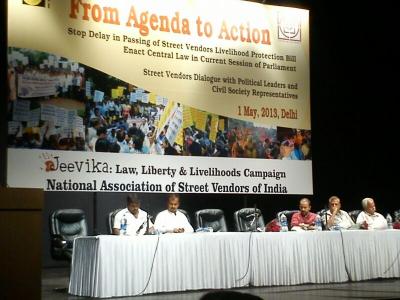 Street Vendors Dialogue with Political Leaders and Civil Society Representatives to Convert Street Vendors Livelihood Protection Bill into the Act
Street Vendors Dialogue with Political Leaders and Civil Society Representatives to Convert Street Vendors Livelihood Protection Bill into the Act
New Delhi, 1 May: Thousands of street vendors’ representatives gathered on International Labour Day at the” Street Vendors Dialogue with Political Leaders and Civil Society Representatives’ at the Kamani Auditorium, with the Union Minister of Housing and Urban Poverty Alleviation, Ajay Maken, sending a message to the National association of Street Vendors of India (NASVI) that the much awaited Street Vendors (Protection of Livelihood and Regulation of Street Vending) Bill had been approved by the Union Cabinet.
The main purpose of organizing the dialogue was to build momentum on getting effective central law in the current session of parliament through bringing key stakeholders together in support of early enactment of Street Vendors (Protection of Livelihood and Regulation of Street Vending) Act. The national dialogue was organized by the NASVI with support from Centre for Civil Society. Besides several street vendor leaders of Delhi, Punjab, Uttar Pradesh, Bihar, Madhya Pradesh, Rajasthan, Gujarat, Andhra Pradesh, Tamil Nadu and Kerala, the Congress leader and Delhi MP JP Agrawal, former director general of Labour and Welfare S.K. Das, FSSAI functionary Suniti Kumar Gupta and CCS associate director Shantanu Gupta also addressed the convention. Mr. Maken, who was to address the street vendors’ convention, could not turn up because of his presence in the Cabinet meeting. However, his office sent message of the development related to the Bill.
director general of Labour and Welfare S.K. Das, FSSAI functionary Suniti Kumar Gupta and CCS associate director Shantanu Gupta also addressed the convention. Mr. Maken, who was to address the street vendors’ convention, could not turn up because of his presence in the Cabinet meeting. However, his office sent message of the development related to the Bill.
The Bill vetted by the cabinet incorporates the issue of inclusion of vendors doing their business on railway lands. Earlier version of the Bill had excluded the railway vendors and the NASVI had strongly objected to the exclusion. The revised Bill also has greatly empowered the Town Vending Committee (TVC) and given it power to decide ultimately on almost all issues of determining the vending zones. The Bill does also have strong grievance redressal mechanisms.
Describing an inclusive and effective central law as a critical social-political imperative of urbanizing India, NASVI coordinator – Mr. Arbind Singh said, “Once enacted by the parliament, the Act would go a long way in protecting the rights and entitlements of street vendors who earn their livelihood in tough and harsh conditions in cities and towns across India”.
Akriti Gupta


